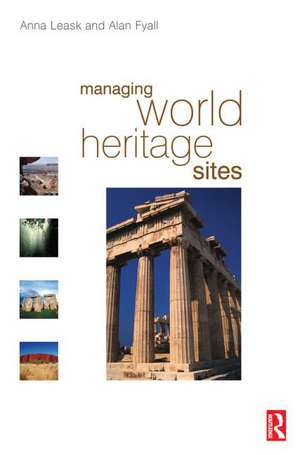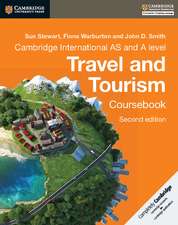Managing World Heritage Sites
Autor Anna Leask, Alan Fyallen Limba Engleză Paperback – 2 mai 2006
Managing World Heritage Sites covers the management issues encountered at cultural and natural UNESCO World Heritage Sites). WHS sites are high profile and as their designation states they are unique. They are often government owned and subject to political debate, they have iconic status and are therefore crucial to national tourism industries, and often involve a large number of stakeholders within their management structures. This text considers all of these aspects in arriving at solutions for site management principles. In 12 chapters and 5 case studies it covers issues such as WHS designation, marketing, visitor management, revenue generation and management. Each chapter will examine the management issues associated with managing heritage within the WH Sites, making clear use of management practices to apply the theory.
Managing World Heritage Sites:
• Includes international case studies such as World Heritage Sites in the Americas, Machupicchu, Stonehenge, Central Eastern Rainforest Reserves of Australia, Megalithic Temples of Malta.• Is authored by an international contributor team of well known and respected experts in this field
• Has a user friendly and logical structure including aims, introduction, case study, conclusion, references and websites and examples best practice.
• 5 specific case study chapters including a location map, an explanation of key issues, conclusion, and questions for self-study
| Toate formatele și edițiile | Preț | Express |
|---|---|---|
| Paperback (1) | 274.23 lei 5-7 săpt. | |
| Taylor & Francis – 2 mai 2006 | 274.23 lei 5-7 săpt. | |
| Hardback (1) | 1109.18 lei 6-8 săpt. | |
| Taylor & Francis – 22 dec 2015 | 1109.18 lei 6-8 săpt. |
Preț: 274.23 lei
Preț vechi: 433.44 lei
-37% Nou
Puncte Express: 411
Preț estimativ în valută:
52.48€ • 54.59$ • 43.33£
52.48€ • 54.59$ • 43.33£
Carte tipărită la comandă
Livrare economică 07-21 aprilie
Preluare comenzi: 021 569.72.76
Specificații
ISBN-13: 9780750665469
ISBN-10: 0750665467
Pagini: 320
Ilustrații: 1, black & white illustrations
Dimensiuni: 156 x 234 x 16 mm
Greutate: 0.59 kg
Ediția:1
Editura: Taylor & Francis
Colecția Routledge
Locul publicării:Oxford, United Kingdom
ISBN-10: 0750665467
Pagini: 320
Ilustrații: 1, black & white illustrations
Dimensiuni: 156 x 234 x 16 mm
Greutate: 0.59 kg
Ediția:1
Editura: Taylor & Francis
Colecția Routledge
Locul publicării:Oxford, United Kingdom
Public țintă
Primary: Undergraduate Levels 3 and 4 and postgraduate students on tourism hospitality and leisure management courses that take options in visitor attraction management. (HESA statistics for 1999 calculated a total of 18,928 students on such degree courses.)Secondary: Practitioners and ug and pg students of business and management with options in tourism and leisure.
Cuprins
Introduction to World Heritage Sites - World heritage site designation (Leask); Implementing the world heritage convention (Hall); Management of World Heritage Sites -Stakeholders and community participation (Millar); Marketing issues and world heritage sites (Boyd and Dallen); Destination management (Parry); Visitor management at world heritage sites (Shackley); Generating and Managing Revenue - Tourism’s contribution to world heritage site management (Cochrane and Tapper); Juxtaposing the timeless and the ephemeral (Smith, Carnegie and Robertson); Information communication technology applications for world heritage site management (Buhalis, Owen and Pletinckx); Strategy -Strategy and policy for the world heritage convention (Ashworth and van der Aa); The future market for world heritage sites (Fyall and Rakic); Case Studies - Visitor management issues at Stonehenge, UK (Mason and Kuo); Sustainable development in tourism (Regalado-Pezua and Arias-Valencia); Managing visitor impacts at Lijiang, China (du Cros); Managing an urban world heritage site (Puczko and Ratz); Tourism development, empowerment and the Tibetan minority (Jiuzhaigou); National Nature Reserve, China (Fung Mei); World heritage sites in the Americas (Dallen and Boyd); World heritage listing: The case of Huangshan (Yellow Mountain), China (Fung Mei and Sofield); The Neolithic Temples of Malta (Theuma and Grima); The Rainforest Ways: Managing tourism in the Central Eastern Rainforest Reserves of Australia (Mackellar and Derrett).
Descriere
World Heritage Sites are some of the most recognised locations around the world. They include natural sites such as the Grand Canyon and the Great Barrier and cultural ones such as the Pyramids at Giza, the Walled City of Baku in Azerbaijan and the Historic Centre of Riga in Latvia. The responsibility to manage them successfully and ensure that the resources are not damaged by visitors, war or environment is therefore vital.
Managing World Heritage Sites covers the management issues encountered at cultural and natural UNESCO World Heritage Sites). WHS sites are high profile and as their designation states they are unique. They are often government owned and subject to political debate, they have iconic status and are therefore crucial to national tourism industries, and often involve a large number of stakeholders within their management structures. This text considers all of these aspects in arriving at solutions for site management principles. In 12 chapters and 5 case studies it covers issues such as WHS designation, marketing, visitor management, revenue generation and management. Each chapter will examine the management issues associated with managing heritage within the WH Sites, making clear use of management practices to apply the theory.
Managing World Heritage Sites:
• Includes international case studies such as World Heritage Sites in the Americas, Machupicchu, Stonehenge, Central Eastern Rainforest Reserves of Australia, Megalithic Temples of Malta.• Is authored by an international contributor team of well known and respected experts in this field
• Has a user friendly and logical structure including aims, introduction, case study, conclusion, references and websites and examples best practice.
• 5 specific case study chapters including a location map, an explanation of key issues, conclusion, and questions for self-study
Managing World Heritage Sites covers the management issues encountered at cultural and natural UNESCO World Heritage Sites). WHS sites are high profile and as their designation states they are unique. They are often government owned and subject to political debate, they have iconic status and are therefore crucial to national tourism industries, and often involve a large number of stakeholders within their management structures. This text considers all of these aspects in arriving at solutions for site management principles. In 12 chapters and 5 case studies it covers issues such as WHS designation, marketing, visitor management, revenue generation and management. Each chapter will examine the management issues associated with managing heritage within the WH Sites, making clear use of management practices to apply the theory.
Managing World Heritage Sites:
• Includes international case studies such as World Heritage Sites in the Americas, Machupicchu, Stonehenge, Central Eastern Rainforest Reserves of Australia, Megalithic Temples of Malta.• Is authored by an international contributor team of well known and respected experts in this field
• Has a user friendly and logical structure including aims, introduction, case study, conclusion, references and websites and examples best practice.
• 5 specific case study chapters including a location map, an explanation of key issues, conclusion, and questions for self-study






















